History of Whitewater Rafting
Posted May 10, 2023 by Gregg Armstrong, Co-Founder
California has played an enormous part in the history of whitewater rafting. The Golden State has one of the highest concentrations of navigable whitewater rivers in the world. It serves as a central and key hub of the sport giving people the widest choice of whitewater experiences ranging from the easiest to the most difficult commercial rafting trip in the US. But how did it all begin?
Early History of Whitewater Rafting
Pre-1800’s: Native Americans
Indigenous Americans were the first to navigate rivers and rapids in search of fish, game and new lands. Although these adventurous people used canoes rather than “rafts”, they were the first known whitewater travelers in North America.
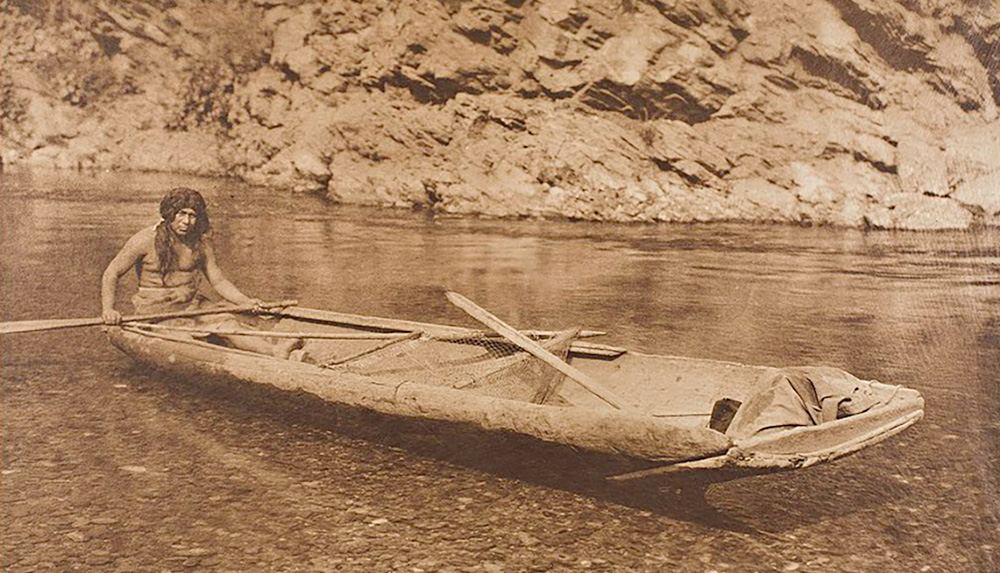
1804-1806: Lewis and Clark
These two men committed themselves to an arduous and dangerous expedition to map and explore the newly acquired Louisiana Purchase west of the Mississippi River. They knew that travel would be easier by water, so they utilized rivers for 80% of their journey. Beginning their trip on the Missouri River in a keelboat, they later switched to canoes and wooden rafts that looked like small floating barges. After a year and half and nearly 4000 miles of travel by river and land, they accomplished their task by reaching the Pacific Ocean at the mouth of the Columbia River.
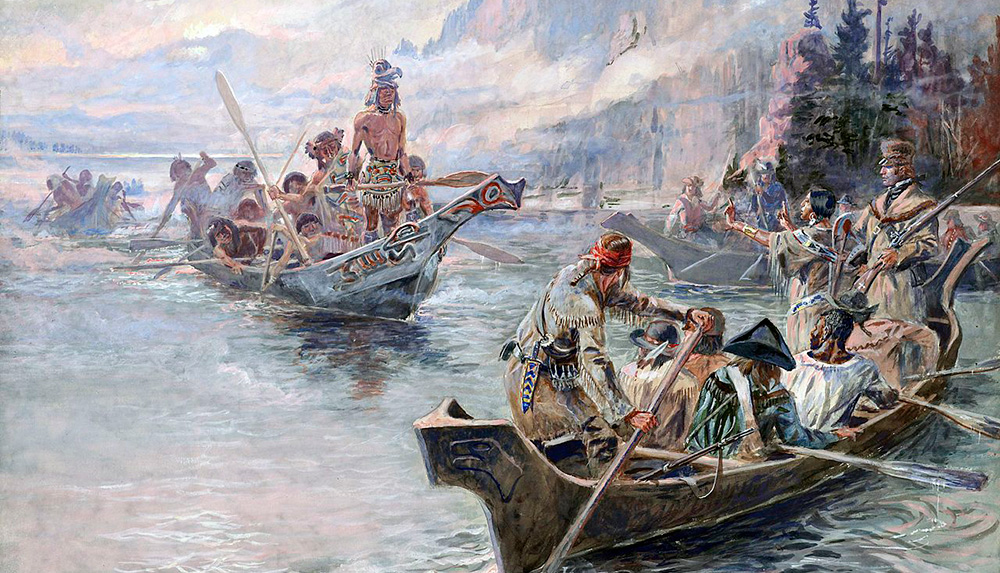
1869: John Wesley Powell
This adventurous and daring fellow headed up one of the most famous “whitewater rafting trips” of all time. Powell was a geologist with a history of river navigation during his youth. In 1869, he was chosen by the US government to lead an expedition to explore and map out the newly acquired remote southwest region of the country. Starting on the Green River in Wyoming, a tributary of the Colorado River, his team encountered many hardships (and many rapids) as they continued downstream on the Colorado and through the magnificent Grand Canyon.
The boats used on this expedition were cleverly designed wood dories which could handle rapids more easily and predictably than a flat wood barge. This was due to the fact they had a front and back end turned upwards and a wooden deck to keep most of the water out as they plunged into whitewater rapids. Wood dories can still be seen today on many rivers, including the Grand Canyon.
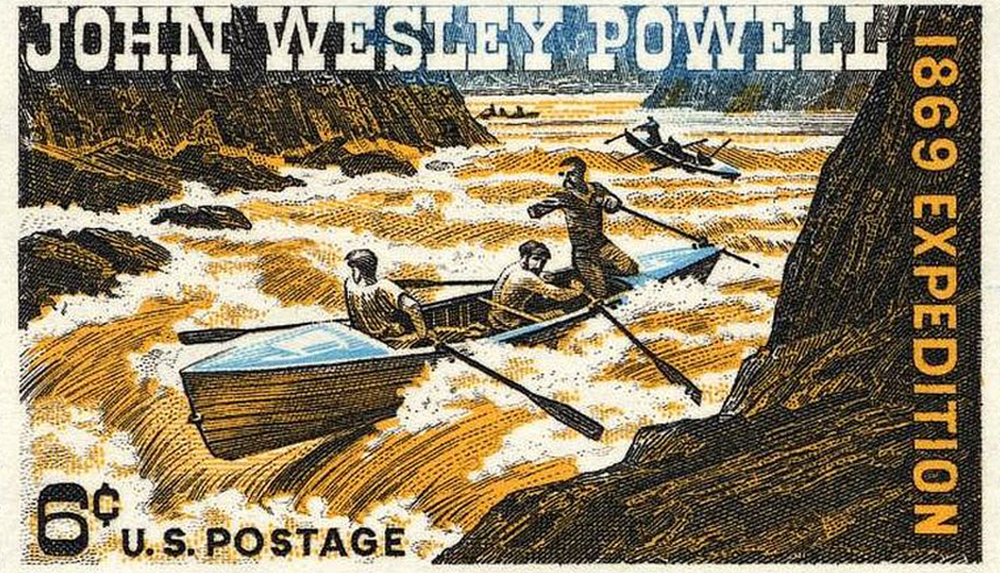
1940’s: Rubber Rafts
Wood dories were used on the earliest commercial river trips that began to be offered on a very limited basis to the general public on the Salmon River in Idaho. But a new type of boat would start shaping the future development of river running.
The first attempts at creating rubber boats date back to the mid 19th century. However, it wasn’t until World War II when rubber rafts became more developed and more available. During the war the US needed a way to get the troops and supplies from large ships in deep water, through shallow water and to the shore of foreign lands. The number of wooden rafts or hard hull boats required for this critical endeavor weighed too much and would take up too much room in the ship during the long journey overseas. A reliable inflatable rubber watercraft was the answer.
This type of boat could be rolled up and stored in a small space, inflated quickly and easily, and get the men and supplies to shore. It was a perfect solution to a problem faced by our government. Rubber rafts helped solve another problem: how to move people down whitewater rivers safely while navigating between rocks and through rapids! This new military watercraft made it possible for humans to access and enjoy some of the most beautiful rivers and canyons on earth.
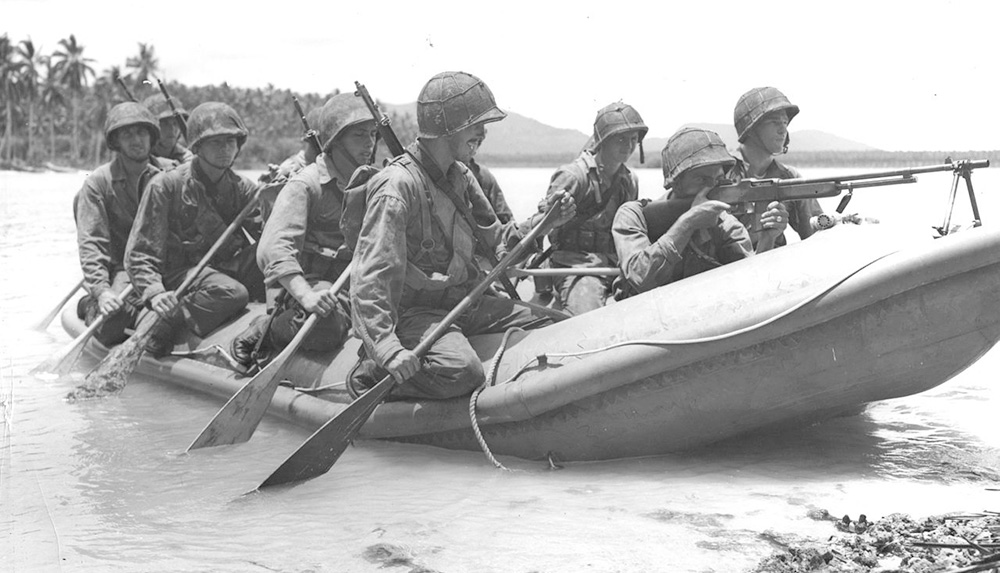
1950’s: Army Navy Surplus Rafts
The Northern California cities of Richmond and Vallejo were hubs for ship building during the war. When the conflict was over the ships were no longer needed. Most of the large fleet was returned to the Naval Shipyards in these San Francisco Bay Area towns where they were originally built. Some ships were refurbished and returned to duty but many were unloaded of their cargo and parked in nearby Suisun Bay. There they awaited their final destination and were given the name, “The Mothball Fleet”.
Much of the unwanted surplus cargo was sold in local Army Navy Surplus stores throughout California and beyond. One of the pieces of the discarded cargo were the rubber rafts which had never been available to the general public before this time.
In just a few years these boats started to be used by whitewater guides on rivers throughout the West. One of the most notable examples was the first female river guide and Colorado River outfitter, Georgie White, who famously introduced the “soft boat” (rubber) on a Grand Canyon trip in 1952.

Modern History of Whitewater Rafting
1960’s: Modern Day Whitewater Rafting Takes Flight
Now that rivers could be navigated more easily and safely with army navy surplus rafts, there was a lot to learn! The 60’s became the experimental years of modern day whitewater rafting and many of its early pioneers were right here in California!
Bryce Whitmore, an interesting and adventurous Bay Area based chemist, had been a kayaker for several years with the Sierra Club. Then, in 1960, he gave rafting a try, taking several trips throughout the Western US with a few of his kayaking buddies. In 1961, the year following his initial rafting trips, he decided to start the first whitewater rafting outfitting company. He purchased three army navy surplus “basket boats” and began taking people down the Main Stanislaus River in the Sierra Nevada foothills.
It was on this river where Bryce and George Armstrong, the founder of All-Outdoors first met in 1962. During one of their first river adventures, George and his daughter Sherri got into trouble in their canvas and wood 2-person kayak and were rescued by Bryce’s group. George took notice of the spacious inflatable boats that could easily fit his whole family. After testing this new type of boat himself on one of Bryce’s trips when he guided a boatful of legislators through the remote canyon, he convinced Bryce to sell him one of his basket boats. This launched the infamous Armstrong family rafting trips that lead to the beginning of All-Outdoors California Whitewater Rafting.
During the 1960’s the few people that were involved in the new sport were learning by trial and error, and George was no exception. While the learning phase continued, the popularity of the sport grew. For the next several decades, whitewater rafting became one of the fastest growing recreational water sports in the world.
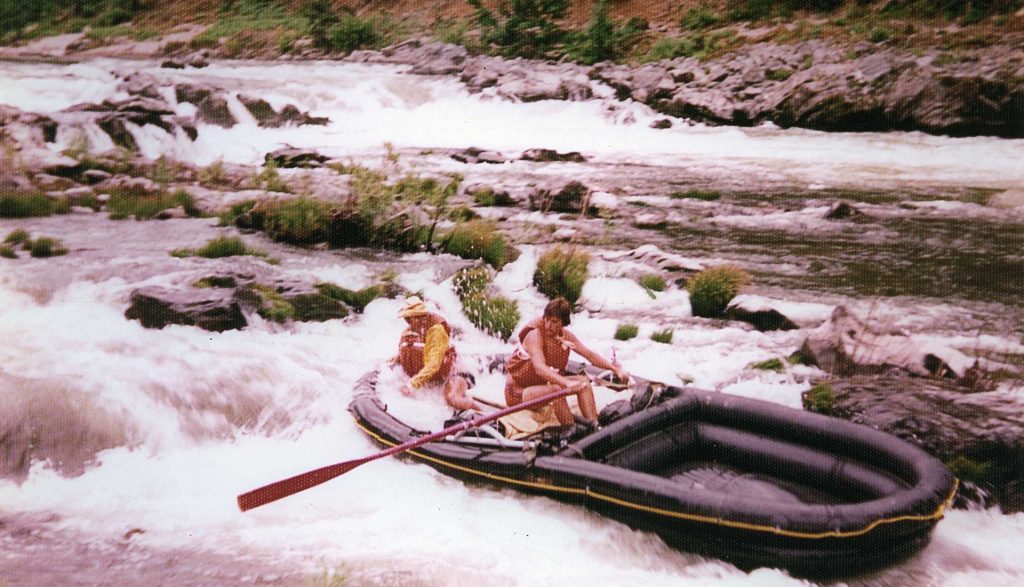
1970’s: Equipment Improves, Interest Grows, River Conservation Begins
With the sport of whitewater rafting becoming more and more popular, the need for better rafts and other equipment became a business proposition that manufacturers could not resist.
One of these manufacturers that really hit the mark was a rubber company in England called Avon. Their engineers started designing rafts specifically to get people down rivers. These high-quality boats were made out of hypalon, a material that was superior to rubber. It was stronger, lasted longer, and was more resistant to abrasion and the sun. The new Avon rafts were also more maneuverable in a river full of obstacles and rapids.
Other whitewater gear was improving rapidly as well, such as life jackets, paddles, oars, raft frames, waterproof containers, etc. Rafting was becoming a thing and so were the “tools” necessary to do it. Discarded army navy surplus equipment was no longer the only option.
As the pristine river canyons became accessible, more people became interested and invested in the various decisions regarding river manipulation and preservation. The California rafting community played a major role in the birth of modern-day river conservation during this decade when the popular whitewater rafting destination, the Main Stanislaus River was lost to the New Melones Reservoir. This sad loss sparked a huge conservation movement that spread way beyond California. Since then, many waterways have gained permanent protection as Wild and Scenic Rivers ensuring that these beautiful canyons are set aside for the benefit and enjoyment of present and future generations.
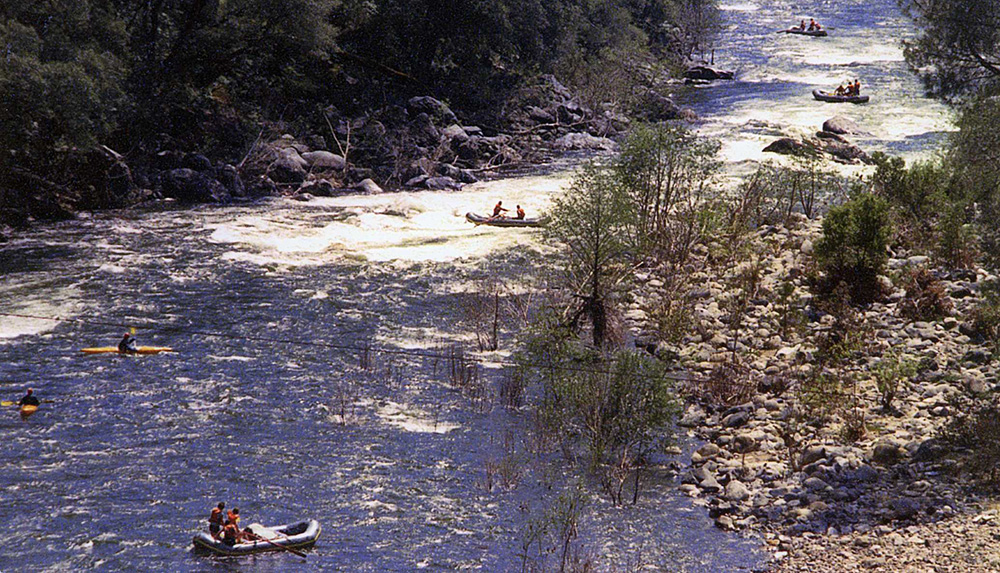
1980’s: New Horizons
The sport of whitewater rafting continued to grow and equipment kept improving during the 1980’s. The most significant advancement of this decade was the introduction of self-bailing rafts. Until this time, rafts had an enclosed single-ply layer of material at the bottom that trapped all the water that came inside. This meant that it was necessary to manually get water out with bail buckets in between rapids. Self-bailers feature an inflatable floor with holes along the perimeter that allows water to escape on its own. This change took a while to get used to (many guides preferred the older bucket boats at first) but eventually this type of raft became the norm.
Rafting knowledge and techniques rose to a new level. Rivers that were once thought to be too difficult to raft were now being explored. Flows that were previously considered too high to run were being attempted. People were beginning to push the envelope on rivers and found it to be much more reasonable than expected! These dynamic factors (better equipment and more knowledge and experience), coupled with an ever increasing interest in rafting, led to expansion of the sport to more and more rivers. In California, there were two main rafting rivers in the 1960’s – the Main Stanislaus River, and the South Fork of the American River. By 1989 that number grew to more than two dozen. The same expansion was happening in other parts of the US and eventually in other countries.
With a larger number of rivers and rafters, government agencies like the US Forest Service, Bureau of Land Management, and California State Parks, became involved. Permits that regulated the number of trips, rafts, and people were instated. These permits included important mandates and requirements designed to protect rivers and their fragile environments, while giving the general public access for the purpose of personal enjoyment and benefit. Fortunately, All-Outdoors was one of the few original California outfitters and as a result was given permits on over 10 premier rivers.
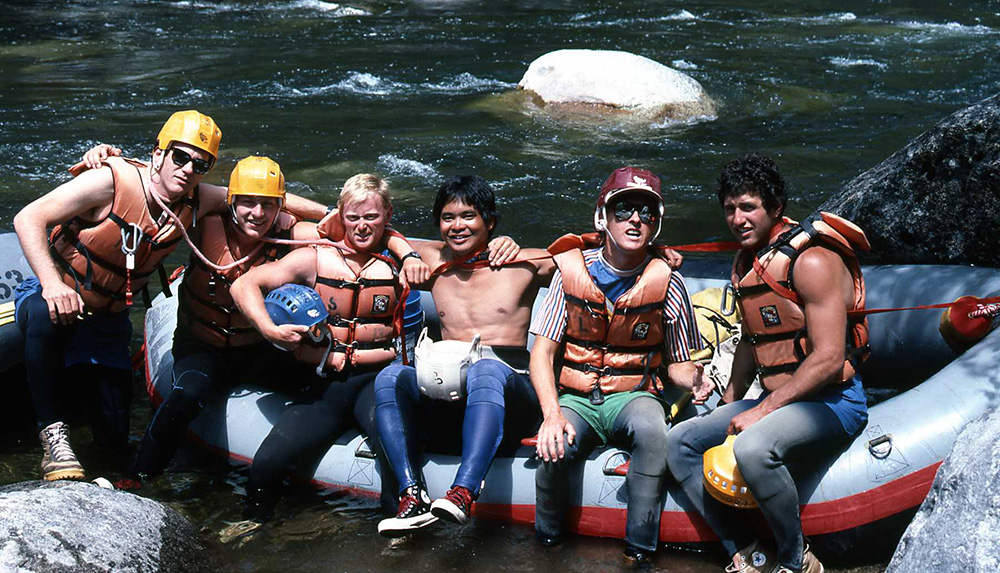
1990 – Today: Rafting Matures and Becomes Part of Everyday Life
Once we got into the 1990’s, whitewater rafting in California was no longer considered a fringe and novel sport conducted by a few adrenaline-seeking enthusiasts. By the end of the millennium it became a fully accepted pastime activity for families, groups of friends, school field trips, and as a teambuilding off-site for companies. After the wild boom of the 80’s when new outfitting businesses were cropping up left and right, the outfitter scene became well-established with new river permits no longer easily available.
The river communities and local governments came to realize that rafting and rafters were now part of society’s fabric. The rafting industry started to play an important role in the regional economies with other businesses thriving as a consequence. The various entities responsible for regulating water releases from reservoirs above the whitewater sections embraced rafters and kayakers as valid stakeholders side by side farmers, electric companies, and water districts downstream. As a result, rafters can now count on predictable flow schedules on dam-controlled rivers throughout the summer and fall, even in drought years.

Looking Back and Looking Forward
When we look back on more than 60 years of our involvement in the evolution of modern-day whitewater rafting, we can only say that it has been a beautiful experience, privilege, and honor for which we are so grateful. To be one of the early explorers of a new recreational frontier has been an amazing journey. We have discovered and experienced so many incredible places and have done so with countless wonderful and enjoyable people.
We do not know what the next 60 years will entail, but one thing is certain… If there are rivers to be run and people who want to raft, we will be there to take them. Together we’ll take another journey into the wild aspect of rivers and experience their power to transform not only the landscape through which they travel, but also the people who float on them.
